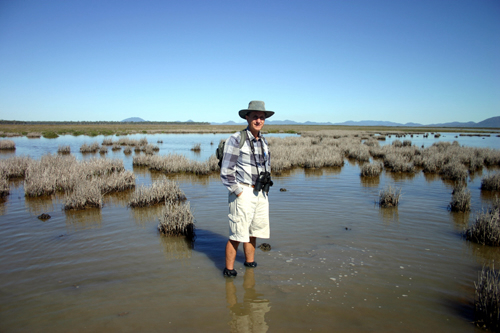Preventing a perilous future for the Capricorn yellow chat

Walking through the water channels of central Queensland in search of the Capricorn yellow chat, volunteers like Allan Briggs understand the perilous future of the small, vibrant bird.
Allan is the Secretary of Birdlife Capricornia and Chair of the Capricorn yellow chat working group established in 2021 to coordinate stakeholders involved in research, recovery and management of this threatened species.
“It takes a collaborative effort to conserve a species,” Allan said. “Community groups, landowners, non-government organisations and the government must cooperate to save this bird.”
In 1991, a small population of Capricorn yellow chats was found on Curtis Island after the bird was thought to be locally extinct. The re-discovery triggered a question – can we find it in other places? A small group of volunteers, including researchers from Central Queensland University, started searching, and over the years, they have found other small populations.
The group of volunteers have undertaken population and habitat surveys for the Capricorn yellow chat since 2002. More recently, Birdlife Capricornia has received funding from the Queensland Government and the Fitzroy Basin Association to help volunteers travel and logistics to conduct the surveys. The volunteers work with landowners and the defence forces to arrange access to their properties.

“We survey six locations at least once a year, sometimes twice, and spend one to four days camping onsite and walking the marine plains, looking for the bird with our binoculars,” Allan said.
“These are small, isolated populations with perhaps 50 birds per location and no evidence that the birds move between populations.
“During the winter months, we thought the Twelve Mile population disappeared until, thankfully, we found them feeding on the muddy edges of the Cheetham Salt evaporation ponds.”
A fire on Curtis Island in 2023 burnt 80% of that population’s habitat. The first survey after the fire found only five birds. Subsequent surveys have recorded up to 20 birds, but this example shows how one event could wipe out a population.
The birds are vulnerable to the impacts of climate change, especially sea level rise. Saltwater inundations can flood and damage the sedge growing along the edge of water channels where the birds live. Birdlife Capricornia has tested mitigation strategies, such as check banks, to divert sea water from their habitat, but it is hard to hold the tide back.
Central Queensland University has organised banding and genetic research for the Capricorn yellow chat. In 2022, a specialist team travelled from Brisbane to Curtis Island to set up mist netting, retrieve feathers for DNA sampling, band and release the birds. Scientists will compare the Curtis Island population’s DNA with previous mainland samples to see if the populations are diverging.
Birdlife Capricornia has also developed a book, brochures and a puppet show for schools and community events to increase awareness about the peril of the Capricorn yellow chat.


